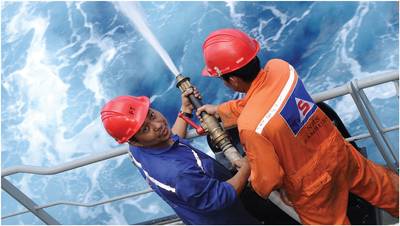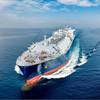Coming your way, a 3% rise in Operating Costs
A new survey from Moore Stephens finds that vessel operating costs are expected to rise by more than 3% in both 2013 and 2014. While this news should not be unexpected it is nevertheless bad news for ship owners that continue to struggle with low freight rates and over capacity across several oceangoing sectors. In total the survey examined 10 main cost areas, summarized in charts one and two. Crew expenses, broken in two categories as ‘wages’ and ‘other’ by far dominated the cause of cost escalation, accounted for a 4.5% rise in 2013 and a projected 4.7% rise in 2014.
“Crew costs, as always, emerged as a major concern for respondents, which is no surprise given the potential budgetary implications of the entry into force of MLC 2006 and the increasing involvement of both international and regional bodies in the oversight of crew competence and its effect on safety,” said Richard Greiner, Moore Stephens shipping partner.
Running neck-and-neck though were cost increases due to rising insurance costs, with P&I insurance expected to escalate 2.4% in 2013 and by 2.5% in 2014, and hull & machinery insurance projected to increases 2.0% and 2.3%, respectively.
Expenditure on spares is expected to increase by 2.1% and 2.3% in 2013 and 2014 respectively, while respondents anticipate a 2.2% increase in the cost of lubricants in both years under review. The cost of stores is expected to increase by 1.9% and 2.0% respectively for 2013 and 2014, while repairs & maintenance expenditure is predicted to increase in those two years by 2.3% and 2.4% respectively.
Drydocking costs over the same period are expected to rise by 2.1% and 2.4% respectively. Meanwhile, as was the case in the 2012 survey, management fees are deemed likely to produce the lowest level of increase in both 2013 and 2014, at 1.4% and 1.7% respectively.
The cost of fuel occupied the thoughts of a number of respondents, one of whom noted, “Fuel costs remain the biggest chunk of our operating expenses due to surging price increases.”
Referring to political volatility in the Middle East and increasing regulation on sulfur emissions levels, another respondent predicted that many owners would “have to switch to Marine Gas Oil, which will involve a very big cost increase. We have already seen how the switch between high and low-sulfur fuel is causing problems for some ships, and instances of black-outs and loss of power are on the increase.”
Moore Stephens also asked respondents to identify the three factors that were most likely to influence the level of vessel operating costs over the next 12 months. Overall, 21% of respondents (compared to 27% in last year’s survey) identified finance costs as the most significant factor, followed by crew supply (20%), competition (18%), demand trends (16%) and labor costs (13%). The cost of raw materials was also cited by 10% of respondents as a factor that would account for an increase in operating costs.
“Ship operating costs fell by an average of 1.8% across all the main ship types in 2012, so at first blush the predicted increase in costs for this year and next might come as something of a disappointment,” said Greiner. “In truth, however, the levels of increase anticipated for 2013 and 2014 are still way below many of those we have seen in recent years.”
In regards to increased costs for underwriting, Greiner said “the projected rise in P&I premiums for 2013 and 2014 can be attributed, among other things, to a number of major casualties to which the clubs and their reinsurance underwriters have had to respond, as well as to the escalating cost of wreck removal. For these reasons, the anticipated cost increases are not unexpected. The fact that the projected increases for hull & machinery cover are lower than those for P&I is perhaps an illustration of the difference between physical loss & damage cover and third-party liability cover, and of the distinction between commercial and mutual insurance.”
By the Numbers
Chart 1
Cost type (mean) 2013 2014
Crew wages 2.4% 2.5%
Other crew 2.1% 2.2%
Lubricants 2.2% 2.2%
Stores 1.9% 2.0%
Spares 2.1% 2.3%
Repairs & Maintenance 2.3% 2.4%
H&M Insurance 2.0% 2.3%
P&I Insurance 2.4% 2.5%
Management fees 1.4% 1.7%
Dry docking 2.1% 2.4%
Total operating costs 3.0% 3.2%
Source: Moore Stephens
Chart 2
By Vessel Type
Expected % Cost Increases for Year Ending December 31, 2014
Mean Bulkers Tankers Container Offshore Total
Ships
Crew wages 2.2% 2.4% 2.8% 3.4% 2.5%
Other crew 1.9% 2.3% 2.5% 2.9% 2.2%
Lubricants 2.1% 2.2% 2.6% 2.5% 2.2%
Stores 2.0% 2.0% 2.1% 2.2% 2.0%
Spares 2.3% 2.4% 2.4% 2.2% 2.3%
Repairs &
Maintenance 2.4% 2.6% 2.4% 2.4% 2.4%
H&M Insurance 2.2% 2.3% 2.8% 2.2% 2.3%
P&I Insurance 2.6% 2.4% 3.0% 2.0% 2.5%
Management
Fees 1.5% 1.7% 2.1% 2.1% 1.7%
Dry docking 2.2% 2.3% 3.1% 2.5% 2.4%
Total costs 3.0% 3.2% 3.6% 3.5% 3.2%
Source: Moore Stephens
(As published in the December2013 edition of Maritime Reporter & Engineering News - www.marinelink.com)












